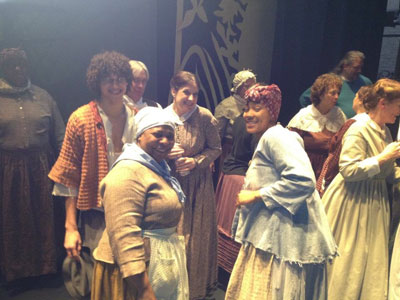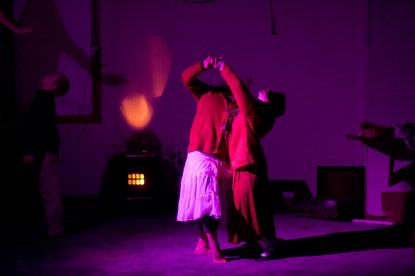“Creativity is contagious. Pass it on.”
–Albert Einstein

It struck me as I was standing on the lip of the stage at the opening of TRUTH, the new folk opera about Sojourner Truth that we commissioned two years ago. There was a collective joy that all 841 of us felt as we recognized each other as creative collaborators. The boisterous applause said, “Look what we did together!” It was a revelation that has been with me since.
I’ve felt that reciprocal creative relationship with audiences for years but in recent months it has been gathering some kind of exponential steam. For instance, our Double Take Fringe Festival in November 2011 felt like a surprise party for the performing arts as hundreds of new and old friends joined in. And when Old Deerfield Productions proposed a community engaged “Madwoman of Chaillot” to the owners of Artsblock and the Pushkin Gallery this summer to continue the momentum we were met with nothing but “yes.” So June 29-July 8 we will celebrate downtown Greenfield as the City of Light with the streets filled with jubilant performers and local luminaries as we prove that “nothing is ever so wrong in this world that a sensible woman can’t set it right in the course of an afternoon.”
So what is going on? Why so much “yes” now? Has Richard Florida’s creative economy finally taken hold here? In the Valley we have a strong sense of pride in place. We love our home. And we love who we are in our home. The creative community has historically thrived in the perhaps more affluent towns of Amherst and Northampton. What is shifting is the sense of creative ownership in the outlier communities like Holyoke, Greenfield, and Springfield. Our Venn diagram is growing more circles! Something is greasing the flywheel in new ways but why?
Have we reached some kind of creative critical mass? Are there enough creators, innovators and artists who collaborate that resistance is diminishing? Does the world communicate so easily that collaborating has become the new normal? We’ve learned that putting the water cooler in a central location fosters innovation. Have our smart phones become the new water cooler? Do we finally understand that we all are artists?
Maybe we should leave these questions for the great data crunchers who make sense of it all and, rather than ask why “yes”, ask what does “yes and” look like? One thought toward “yes and” might be to take these collaborative relationships and expand them. We already have a strong network of performing arts collaborators creating with a high level of Q. What is Q? I read about it in Imagine: How Creativity Works, by Jonah Lehrer. The following excerpt describes the intimacy and strength of social networks involved in Broadway productions:
Brian Uzzi, a sociologist at Northwestern, has spent his career trying to answer these crucial questions (how do we best work together) and he’s done it by studying Broadway musicals….Uzzi spent five years analyzing thousands of old musicals because he sees the art form as a model of group creativity….Uzzi undertook an epic study of nearly every musical production on Broadway between 1877 and 1990, analyzing the teams behind 2, 258 different productions…(he) discovered that people who worked on Broadway were part of an extremely interconnected social network: it didn’t take many links to get from the librettist of Guys and Dolls to the choreographer of Cats. Uzzi then came up with a way to measure the density of these connections… a designation he called Q. In essence the amount of Q reflects the “social intimacy” of people working on the play, with higher levels of Q signaling a greater degree of closeness….a team of artists who worked together several times before… (were seen as) less risky – that musical would have an extremely high Q. In contrast, a team of strangers would have a low Q.

In the performing arts we are used to working with a pretty high level of Q. We work repeatedly with our favorite choreographers, composers, playwrights, designers to make work that we seek to make meaningful. Many are reaching further to collaborate with other artists: painters, sculptors, puppeteers, humanists, poets, sculptors, filmmakers, animators, and more to create events where we gather to be lifted. Take, for example, how Andy Baio is making it happen in Portland with the XOXO Festival. All are exciting ways to expand our Q but there are further reaches that are waiting to be explored.
Let’s reach past our comfort zones into other disciplines to create art that explores problems. This is not a new idea but surely isn’t yet the norm. As an example, let’s invite art and science practitioners to form high Q relationships here in the Valley. Let’s look to form a coalition between the Green Movement and the Performing Arts community. These events and festivals could fill our streets and empty buildings. The Turners Falls River Culture is a great step forward. What about health, poetry and dance? Social Justice, puppetry, and animation? Let’s meet the creators doing this work already and think about how can we bundle that work to spread it further. And let us educate our children to increase the collective Q by offering them the chance to cross disciplines and make collaborative art for credit. Surely some are doing this already, let them teach the rest of us how to teleport through the rigid walls of departments and colleges. It’s more than possible and yearning to happen. I know it is because we recognized each other across the footlights. I felt it and so did you.
PHOTOS, Top to Bottom:
Backstage TRUTH photo by Kenneth Hanson
“Tesseract” by John Bechtold taken from his original production of the same name for Double Take Others


